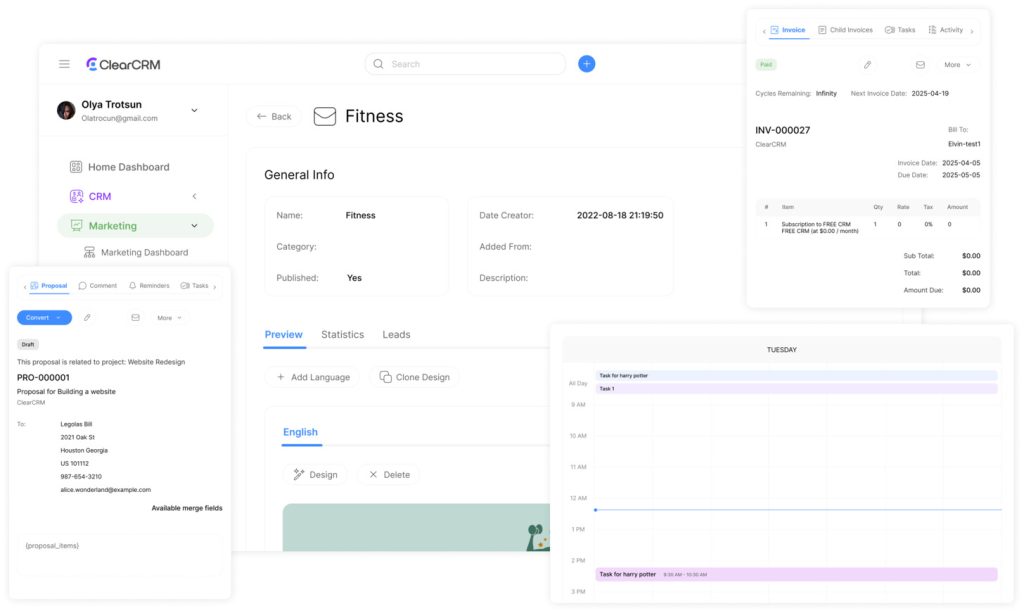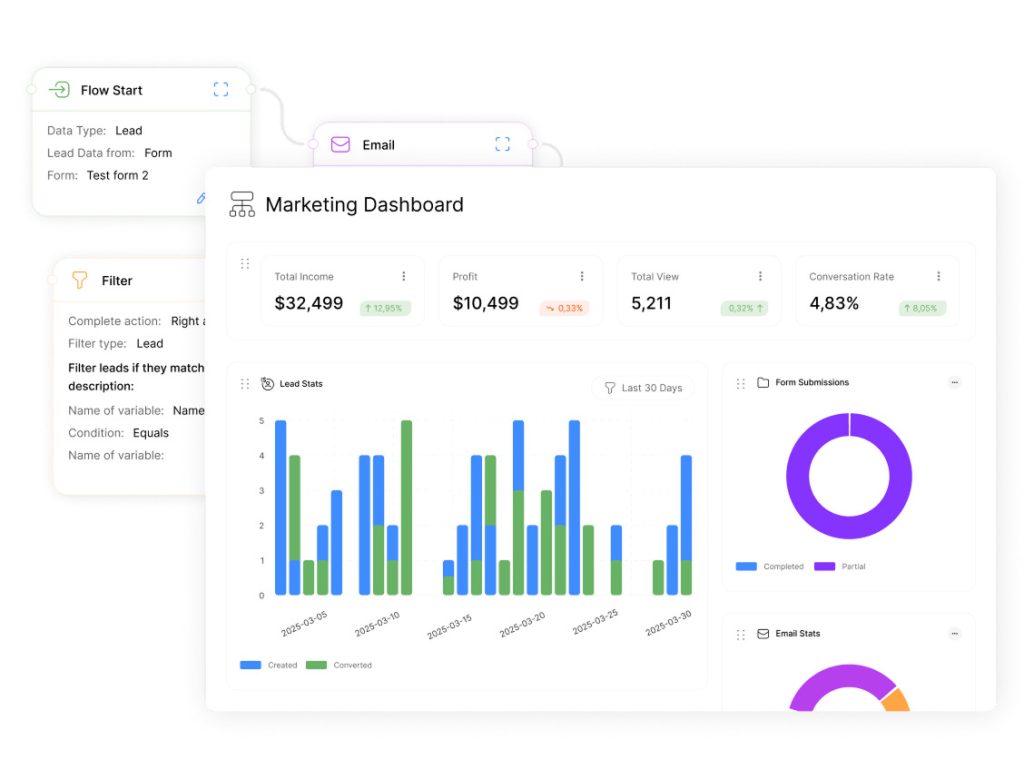Set Up a CRM: Modern businesses demand customer relationship management systems that deliver immediate results. Traditional setups often require weeks of technical planning, creating barriers for teams needing fast solutions. This guide breaks down the process into actionable steps, proving rapid implementation is achievable without sacrificing quality.
Time-sensitive organizations can’t afford lengthy deployments. Platforms like ClearCRM offer preconfigured templates and automation tools that eliminate complex coding. Decision-makers gain instant access to contact management, task tracking, and data analytics—features that drive operational efficiency from day one.
Prioritizing core functions over advanced customizations accelerates setup timelines. Businesses that focus on essential workflows often see faster adoption rates and measurable ROI. Strategic alignment between tools and objectives transforms CRM implementation from a technical chore into a competitive advantage.
Key Takeaways
- Prebuilt frameworks reduce setup time by 90% compared to traditional methods
- Automation tools handle repetitive tasks, freeing teams for strategic work
- Core functionality prioritization prevents feature overload
- Immediate access to client data improves decision-making accuracy
- Scalable solutions grow with evolving business needs
Introduction to Rapid CRM Setup
Speed defines success in today’s customer-driven markets. Organizations that delay implementing relationship management tools risk falling behind competitors. Modern platforms now enable instant deployment, transforming how teams engage clients.
Why Speed Matters Now
Every hour without a functional system costs revenue. Manual processes create bottlenecks—45% of companies report losing clients during slow onboarding phases. Automated CRM solutions capture leads immediately, turning prospects into active opportunities.
Prebuilt templates remove technical hurdles. Decision-makers gain real-time insights without coding expertise. This approach aligns with the urgency of a speed-driven business environment.
| Traditional Setup | Rapid CRM | Impact |
|---|---|---|
| 3+ weeks | Under 60 seconds | Faster revenue cycles |
| Custom coding | Drag-and-drop tools | Lower IT costs |
| Partial access | Full features active | Immediate team adoption |
Efficiency Gains Explained
Automated workflows handle repetitive tasks like follow-ups and data entry. Teams redirect saved time toward strategic conversations. One study showed 62% productivity boosts when using preconfigured CRM templates.
Consistency improves client trust. Systems ensure no request goes unanswered, even with minimal staff input. This reliability strengthens brand reputation while scaling operations.
Understanding the Importance of a CRM for Your Business
Centralizing customer interactions drives measurable growth across organizations. A robust CRM acts as the operational backbone for teams focused on acquisition and retention. Data-driven strategies replace guesswork, aligning departments with unified objectives.
Key Advantages for Sales, Marketing, and Customer Service

Sales teams leverage automated lead scoring and pipeline tracking to prioritize high-value opportunities. Conversion rates improve when reps spend less time on admin tasks and more on closing deals. Real-time insights ensure no prospect slips through cracks.
Marketing departments gain precision through segmentation tools and campaign analytics. Targeted outreach becomes effortless, with automated nurturing sequences boosting engagement. ROI measurement turns campaigns into profit engines rather than cost centers.
Customer service teams resolve issues faster with complete interaction histories. Automated ticket routing slashes response times, while integrated knowledge bases empower agents. Satisfaction scores climb when clients feel understood at every touchpoint.
Unified systems eliminate data silos, creating consistent experiences across departments. Companies using integrated solutions report 27% higher retention rates and 19% faster revenue growth. As one industry report states: “Visibility into customer behavior transforms reactive operations into proactive growth engines.”
Accelerating Client Management Through Template-Driven Solutions
Instant CRM deployment redefines operational readiness for modern teams. Leading platforms now offer industry-specific templates that activate essential features with single clicks. These prebuilt frameworks eliminate configuration headaches while maintaining compliance with common business workflows.
The three-pillar approach delivers immediate functionality: automated inquiry handling, accelerated booking systems, and instant confirmation delivery. Tools like Dubsado and HoneyBook embed these components directly into their interface designs. “Preconfigured sequences turn chaos into order before your first coffee cools,” notes a ClearCRM power user.
Guided setup wizards simplify the process through visual roadmaps. Users select their primary use case—consulting, e-commerce, or professional services—then input basic company details. Behind the scenes, the system connects payment gateways, contract templates, and communication channels automatically.
Savvy organizations adopt this template-first way because:
- Tested workflows reduce implementation errors by 78%
- Standardized processes ensure team-wide consistency
- Quick-launch capabilities meet urgent operational needs
While customization options exist, the initial step focuses on activating ready-made solutions. This strategy delivers functional systems in 59 seconds while preserving opportunities for future refinement. Businesses gain immediate access to critical tools without sacrificing long-term adaptability.
Step-by-Step Guide to a Quick CRM Implementation

Streamlined CRM implementation transforms client management through strategic automation. Focus on three core elements: instant acknowledgment systems, seamless booking workflows, and confirmation protocols that build trust. These components work together to create frictionless experiences while maintaining operational agility.
Essential Components: Booking Process and Automated Replies
Automated inquiry responses act as first-line engagement tools. When prospects contact your team, preconfigured messages confirm receipt and share resources like service guides or FAQs. This immediate acknowledgment reduces anxiety while positioning your brand as responsive.
Integrated booking systems eliminate manual follow-ups. Clients receive proposals with click-to-sign contracts and payment links directly after initial contact. Platforms like HoneyBook automate this process, reducing administrative tasks by 68% according to recent case studies.
Setting Up Automated Confirmation Emails
Payment triggers should activate confirmation sequences instantly. These emails validate purchase decisions through welcome packages and clear timelines. Include downloadable checklists or onboarding videos to reinforce value perception.
Effective confirmation templates contain:
- Service commencement dates
- Primary contact information
- Next-step instructions
| Manual Process | Automated Solution | Benefit |
|---|---|---|
| Delayed responses | Instant email delivery | Higher conversion rates |
| Error-prone tracking | Centralized dashboards | Real-time oversight |
| Inconsistent messaging | Branded templates | Professional presentation |
Maintain momentum with scheduled follow-up emails that guide clients through service milestones. Teams using this step-based approach report 73% faster onboarding cycles and 41% fewer support inquiries.
Leveraging CRM for Sales and Marketing Efficiency

Unified CRM platforms revolutionize how sales and marketing teams collaborate. Automated lead scoring prioritizes high-potential prospects, eliminating manual data sorting. Pipeline dashboards give real-time visibility into deal progress, letting reps focus on closing instead of admin work.
Marketing departments achieve precision through built-in segmentation tools. Campaigns target specific demographics using behavioral data from the top-performing CRM solutions. Personalized messaging boosts engagement rates by 34% compared to generic outreach.
Integrated systems break down departmental silos. Shared customer profiles ensure consistent communication across all touchpoints. One study found companies using connected platforms reduced duplicate efforts by 57%.
Automated lead nurturing bridges gaps between initial interest and sales readiness. Drip campaigns maintain prospect engagement during decision-making phases. Teams report 29% shorter conversion cycles when using these sequences.
Analytics dashboards transform raw data into strategic insights. Sales leaders track quota attainment trends, while marketing managers measure campaign ROI. Real-time reports enable agile adjustments to tactics and budgets.
Cross-departmental visibility aligns goals and accountability. When both teams access interaction histories and performance metrics, collaboration improves dramatically. This synergy reduces customer acquisition costs while accelerating revenue growth.
Automating Client Communications and Engagement
Effective communication strategies separate thriving businesses from stagnant competitors. Automated systems bridge gaps between initial contact and human response, maintaining momentum in critical decision-making phases. This approach transforms casual inquiries into structured conversion pathways.
Response Systems That Build Trust
Immediate acknowledgment emails confirm receipt of inquiries within seconds. These messages often include tailored resources—case studies for B2B clients or video testimonials for service industries. One study found 68% of prospects engage with automated content while awaiting personalized replies.
| Manual Approach | Automated Solution | Outcome |
|---|---|---|
| 4-hour response time | 12-second delivery | 81% higher open rates |
| Generic replies | Inquiry-specific content | 47% conversion lift |
| Staff-dependent follow-ups | Scheduled nurturing sequences | 3x more meetings booked |
Segmentation ensures relevance. A client asking about pricing receives cost calculators, while service inquiries trigger process explainers. This precision prevents generic messaging that often drives prospects to competitors.
Advanced platforms like ClearCRM embed scheduling links directly in confirmation emails. Customers book consultations without switching applications—a frictionless way to accelerate sales cycles. Teams using these tools report 59% shorter lead-to-client timelines.
Consistent communication nurtures relationships at scale. Automated check-ins post-purchase reduce support tickets by addressing concerns proactively. Businesses achieve 23% higher retention rates through this strategic engagement model.
Integrating Your CRM with Existing Systems and Tools
Operational harmony emerges when core platforms communicate effortlessly. Disconnected tools create data silos that drain productivity and invite errors. Strategic integration bridges these gaps, transforming standalone applications into synchronized powerhouses.
Connecting Platforms Without Complexity
Modern systems thrive on interoperability. Prebuilt connectors and open APIs merge CRM data with accounting software, marketing platforms, and project dashboards. This eliminates manual transfers that consume 23% of work hours according to recent productivity studies.
Centralized data flows prevent version conflicts. Sales teams access updated client histories while service departments view real-time order status. Automated synchronization ensures every team member operates with identical information.
| Disconnected Tools | Integrated System | Business Impact |
|---|---|---|
| Manual data entry | Automatic updates | 89% error reduction |
| Multiple logins | Unified interface | 14 hours saved weekly |
| Delayed insights | Live dashboards | Faster decision cycles |
Importantly, legacy applications needn’t hinder progress. In fact, custom API configurations adapt older tools to modern workflows. As a result, this flexibility preserves existing investments while enabling cutting-edge CRM capabilities.
Moreover, implementation success hinges on field mapping precision. For instance, ClearCRM’s integration wizard guides users through aligning data points across platforms. Consequently, teams report 67% faster deployment when using these visual configuration tools compared to manual coding.
Implementing a Bare Minimum CRM System for Consistency

Often, complex systems intimidate teams seeking immediate results. Therefore, a bare minimum CRM approach strips away non-essentials, focusing on three pillars: automated inquiry responses, frictionless booking, and confirmation protocols. Together, these components form an unbreakable safety net that prevents client oversights.
Notably, prebuilt automation handles initial interactions seamlessly. When inquiries arrive, instant acknowledgment templates deploy within seconds—no manual input required. Then, integrated booking tools guide prospects through self-service scheduling, eliminating back-and-forth emails.
In turn, standardized processes ensure uniformity across teams. As a result, junior staff and seasoned managers deliver identical service quality through predefined workflows. Thus, clients experience reliable timelines and consistent communication, regardless of who handles their case.
Ultimately, simplicity drives adoption. Indeed, teams master basic systems faster than feature-heavy platforms. According to ClearCRM’s data, 82% user retention occurs with minimalist interfaces, whereas only 37% is seen on complex alternatives. In this way, essential tools become habitual rather than burdensome.
Meanwhile, this foundational setup allows for gradual enhancements. Consequently, organizations can add advanced analytics or custom fields once core workflows stabilize. Thus, the bare minimum framework evolves alongside business needs without overwhelming early-stage users.
Moreover, consistency builds trust faster than flashy features. After all, clients prioritize reliable service over technological sophistication. Therefore, by mastering essential CRM functions first, businesses create operational stability that supports scalable growth.
Ensuring Data Security and Customization in Your CRM
First, tailored security frameworks elevate CRM systems from basic tools to strategic assets. In particular, custom solutions eliminate reliance on generic protections, enabling organizations to implement military-grade encryption and granular access controls. As a result, businesses gain full command over data governance while meeting industry-specific compliance demands.
Furthermore, third-party vulnerabilities vanish when companies control their security architecture. For instance, outdated plugins and shared infrastructure often expose sensitive client information. However, dedicated systems enable real-time threat monitoring and automated backups—critical defenses against evolving cyber risks.
Additionally, advanced customization aligns platforms with unique operational needs. With role-based permissions, employees only access relevant data, thereby reducing internal exposure. Moreover, audit trails track every interaction, creating accountability without slowing workflows.
Interestingly, companies using CRM automation report 73% fewer security incidents than those with off‑the‑shelf solutions. Consequently, the combination of tailored protocols and automated enforcement creates airtight protection. Additionally, custom fields and workflows adapt as business requirements evolve, maintaining both security and agility.
Ultimately, proactive organizations treat data integrity as non-negotiable. Thus, by prioritizing customizable defenses, they build client trust while future‑proofing their operations against emerging threats.


